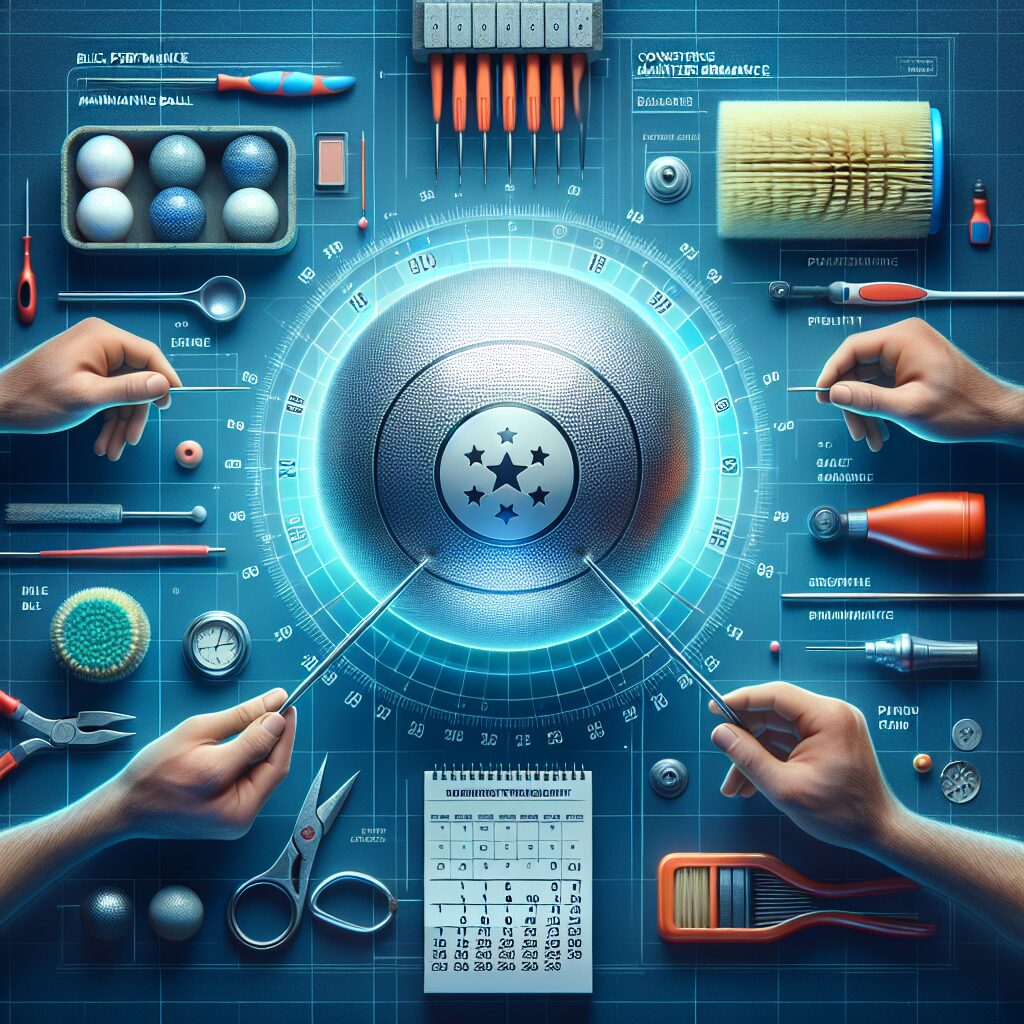Maintenance Schedules: Ensuring Consistent Ball Performance
For sports enthusiasts and professionals, the performance of a ball can make all the difference in the game. Whether it’s a tennis ball, basketball, or cricket ball, the level of performance and consistency directly affects the overall gameplay and outcomes. However, many players and even facility managers overlook the importance of regular maintenance schedules for these essential equipment. Did you know that neglecting proper maintenance can lead to decreased performance, uneven bounces, and even faster wear and tear? With that in mind, it becomes crucial to understand the impact of maintenance schedules on ball performance and how it can significantly enhance the overall playing experience.
One of the most significant reasons why maintenance schedules are essential for preserving consistent ball performance is the prevention of wear and tear. Regular use and exposure to different playing surfaces can gradually degrade a ball’s structural integrity, resulting in reduced performance. By implementing a consistent maintenance schedule, players and facility managers can identify early signs of damage, such as cracks, abrasions, or loss of pressure. This proactive approach allows for timely repairs or replacements, ensuring that the ball remains in optimal condition and maintains its desired performance characteristics. Now, let’s explore the key takeaways to delve deeper into the aspects of maintenance schedules and understand how they contribute to consistent ball performance.
Key Takeaways
1. Regular maintenance is crucial for consistent ball performance and longevity. Without proper maintenance, balls can lose their grip and bounce, negatively affecting the overall gameplay experience.
2. Cleaning the ball regularly helps to remove dirt, dust, and oils that can accumulate and cause the surface to become slick. Using a mild detergent solution and a soft cloth is recommended for effective cleaning.
3. Proper storage is essential to protect the ball’s integrity. Balls should be stored in a cool and dry place, away from direct sunlight and extreme temperatures, to avoid damage to the outer surface and the internal components.
4. Inspecting the ball before each use is important to identify any signs of wear and tear. Look for cracks, dents, or deformations that may affect the ball’s performance and safety. If any damage is found, it should be repaired or replaced before playing.
5. Following the manufacturer’s recommended maintenance schedule is crucial for optimum ball performance. Different types of balls, such as soccer balls, basketballs, or tennis balls, may have specific maintenance requirements, including pressure checks, inflation guidelines, and the use of lubricants or conditioners.
How to Optimize Maintenance Schedules for Consistent Ball Performance?
Why Maintenance Schedules are Crucial for Consistent Ball Performance
In the realm of sports, maintaining consistent ball performance is essential for the success of any team or individual player. This hinges on the implementation of proper maintenance schedules, which ensure that sports equipment, particularly balls, are in optimal condition throughout their lifespan. Let’s delve into the significance of maintenance schedules and explore various aspects related to ensuring consistent ball performance.
The Role of Maintenance Schedules
Maintenance schedules play a pivotal role in upholding consistent ball performance by preventing wear and tear, addressing maintenance issues, and maximizing the lifespan of the ball. By following a well-structured maintenance routine, athletes and team managers can avoid unexpected performance issues, optimize their gameplay, and ultimately achieve their desired results.
Components of an Effective Maintenance Schedule
An effective maintenance schedule encompasses various key components that strive to maintain the performance of the ball. These include:
Regular Cleaning and Inspection
Implementing a routine cleaning and inspection process helps remove excessive dirt, debris, or other unwanted elements from the ball’s surface. Furthermore, it allows for early detection of any indiscernible damage or potential defects, ensuring they are promptly addressed to maintain consistent ball performance.
Proper Storage
Storing the balls in appropriate conditions can significantly impact their performance. Factors such as temperature, humidity, and exposure to sunlight should be considered when devising proper storage solutions. By ensuring ideal storage conditions, the ball’s integrity and performance are preserved over time.
Insightful Data Tracking
Maintaining records of usage, wear patterns, and performance can provide valuable insights into the lifespan and future maintenance requirements of the ball. Utilizing modern technologies, such as ball tracking systems or performance analytics software, enables teams to optimize their maintenance schedules and make data-driven decisions for better performance.
Prompt Repairs and Replacements
When damage or significant wear occurs, immediate action should be taken to initiate repairs or replace the ball. Neglecting such issues may lead to compromised performance or even injury. Having a proactive approach to repairs and replacements ensures that consistent ball performance is not compromised during gameplay.
Beyond Consistent Ball Performance: Added Benefits of Maintenance Schedules
Maintenance schedules not only contribute to consistent ball performance but also provide additional benefits that enhance both the athlete’s experience and the team’s overall success. These advantages include:
– Increased durability and longevity of the ball
– Cost savings by minimizing the need for frequent replacements
– Enhanced safety for players by preventing unexpected equipment failures
– Improved confidence and peace of mind for athletes and coaches alike
Guides to Optimize Your Maintenance Schedule
1. How often should I clean and inspect the balls?
2. What are the ideal storage conditions for maintaining ball performance?
3. Which performance analytics software or tracking systems can aid in data-driven decisions?
4. How do I identify when a ball needs repair or replacement?
By following these practical guidelines, you can establish a well-structured maintenance schedule to ensure consistent ball performance and reap the associated benefits.
Frequently Asked Questions
1. Why is a maintenance schedule important for consistent ball performance?
A maintenance schedule ensures that the ball is regularly cleaned and maintained, which helps to maintain consistent performance. By following a schedule, potential issues such as dirt build-up or loss of grip can be identified and addressed before they affect the ball’s performance.
2. How often should I clean the ball?
The frequency of ball cleaning depends on various factors including usage, conditions, and the type of ball. As a general guideline, it is recommended to clean the ball after every use or at least once a week to maintain optimal performance.
3. What is the best way to clean a ball?
The best way to clean a ball is by using a mild detergent mixed with water. Gently scrub the surface of the ball with a soft cloth or sponge, ensuring to remove any dirt or debris. Avoid using abrasive cleaners or harsh chemicals that can damage the ball.
4. Can I use a ball cleaning machine?
Yes, a ball cleaning machine can be a convenient and effective way to clean your ball. However, it is important to follow the manufacturer’s guidelines and recommendations for proper usage and maintenance of the machine.
5. Are there any specific maintenance measures for different types of balls?
Yes, different types of balls may require specific maintenance measures. For example, bowling balls may require periodic resurfacing or polishing, while tennis balls may need to be replaced after a certain number of games. It is important to refer to the manufacturer’s guidelines for the specific ball you are using.
6. Can I use household cleaning products on the ball?
No, it is not recommended to use household cleaning products on the ball. These products may contain chemicals that can damage the ball’s surface or alter its performance. Stick to using mild detergents or products specifically designed for ball cleaning.
7. How can I store the ball to maintain performance?
It is recommended to store the ball in a cool and dry place, away from direct sunlight or extreme temperatures. Additionally, using a ball storage bag or case can help to protect the ball from dust, dirt, and potential damage.
8. Can I perform maintenance on my ball myself?
Yes, you can perform basic maintenance tasks on your ball yourself, such as cleaning and inspecting for any visible damages. However, for more intensive maintenance procedures like resurfacing or drilling, it is best to seek assistance from a professional or a certified ball technician.
9. Should I follow the ball manufacturer’s maintenance recommendations?
Yes, it is highly recommended to follow the ball manufacturer’s maintenance recommendations. They have extensive knowledge and expertise regarding their specific ball products, and their recommendations are designed to ensure optimal performance and longevity.
10. How can a maintenance schedule save me money?
By following a maintenance schedule, potential issues with the ball can be identified and addressed early on. This can prevent costly repairs or the need for replacement balls. A well-maintained ball also tends to have a longer lifespan, saving you money in the long run.
Final Thoughts
Maintenance schedules play a crucial role in ensuring consistent ball performance. By dedicating time and effort to proper maintenance, you can extend the lifespan of your ball, enhance its performance, and ultimately improve your overall gameplay. Remember to establish a regular cleaning routine and adhere to the guidelines provided by the ball manufacturer to get the most out of your equipment.




